The ExactRail Box - HO Scale

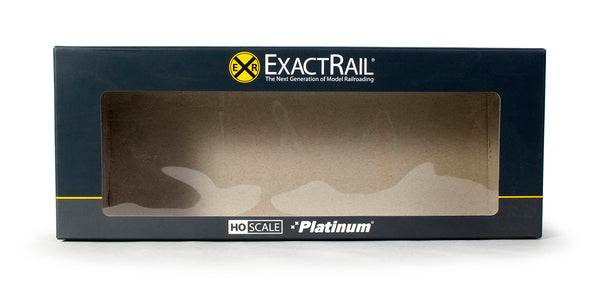
For the railroads, the identity that most know and love are the various paint schemes applied to their locomotives and rolling stock. Over time these identities can change, some a little and others a lot. Much like the railroads, the box and its artwork is what many model railroaders use to identify the different manufacturers of model train products. Like the railroads, the box design can change overtime. Here is a little history of how the ExactRail box came to be and has changed.
In the Beginning...
The name of the concept business as it was proposed to  John Pestana was Premier. The Premier box was white with red and grey accents, and would serve as the foundation for the ExactRail box. (The box art image is not an exact reproduction of the original artwork.) Pestana felt as though the Premier name was overly generic. The internet is full of companies named Premier, from day spas to insurance agencies. He saw a need to create a company name that spoke directly to model train enthusiasts.
John Pestana was Premier. The Premier box was white with red and grey accents, and would serve as the foundation for the ExactRail box. (The box art image is not an exact reproduction of the original artwork.) Pestana felt as though the Premier name was overly generic. The internet is full of companies named Premier, from day spas to insurance agencies. He saw a need to create a company name that spoke directly to model train enthusiasts.
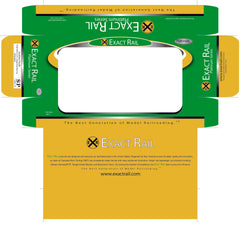 Original designs of the box with the ExactRail brand were tested in a rainbow of colors, one example is the green version to the left. Eventually the colors were decided to be blue & yellow for Evolution Series & N scale products and grey & yellow for Platinum Series products. With the colors decided and a change to the window size, the boxes for the first releases were ready.
Original designs of the box with the ExactRail brand were tested in a rainbow of colors, one example is the green version to the left. Eventually the colors were decided to be blue & yellow for Evolution Series & N scale products and grey & yellow for Platinum Series products. With the colors decided and a change to the window size, the boxes for the first releases were ready.
The Platinum Series Box
The grey and yellow Platinum Series box was relatively short lived, only 3 product releases shipped in it. The boxes went through a full top to bottom redesign. All boxes would now have the same blue and yellow. The product series tags went from an oval in the top right to the "swoosh" with the newly revised series designs. All other design elements of the original box were refined and a small adjustment made to the window size.
In 2013 we introduced the 3rd generation charcoal box. We felt that the current box art was too busy and was becoming dated quickly. We decided to go with a more minimalistic and timeless approach. We had experimented with a few designs, first in N Scale and then on an Evolution Series box, both will be discussed later.
The ovals & swooshes were eliminated and the brand began the transition to charcoal. The new box is simple, clean and with a handsome matt finish. We like this box because it looks great but doesn't draw your attention away from the product inside.
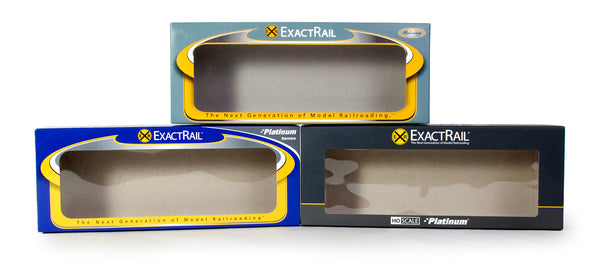
The Evolution Series Box
With only different color queues, the Evolution Series box was always within the same family of the Platinum Series box. Evolution blue came about with the 2nd generation boxes. It was used in the series logo "swoosh" and oval above the window. On the charcoal boxes, the Evolution blue replaced the grey used by the Platinum Series boxes.
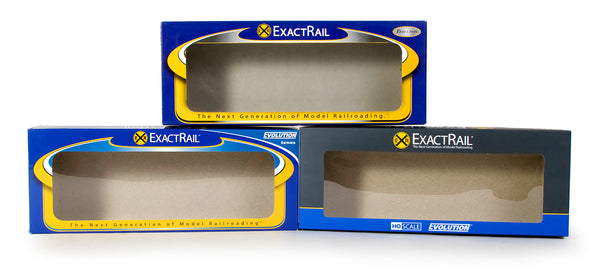
Express & Signature Series Boxes
There has only been 1 box version of the Express & Signature Series, both from the 2nd generation boxes. The Express green and Signature red were the only changes to the boxes from the Platinum and Evolution boxes.
When we do a new release in the Express Series it will follow in the footsteps of the Evolution charcoal box, but substituting the blue with Express green.
Signature Series will most likely not see a new box as this line has effectively been folded into the Platinum Series.
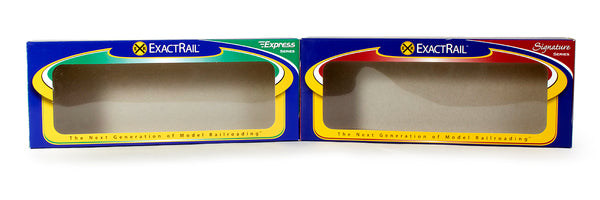
Other Box Styles
Prior to the Charcoal boxes there were a few box & packaging designs that were used.
Artwork needed to be generated for the Brass Irrigation Wheel Line & N scale jewel case inserts as well as a new box size for the 30' & 50' Bridges. This opportunity was used to design new box artwork. Liking the new design, we decided to run with it on future releases, however the ExactRail blue was changed to the current charcoal.
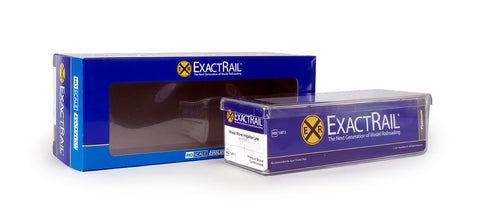
Box Sizes
Because of the various sizes and lengths of the products we have produced. Many different sizes had to be designed to display and protect them.
The two most common sizes are the 10.5x4x2" & the 12x4x2" boxes. Typically a 40' to 50' long freight car goes into the 10.5" box and a 60' to 70' long freight car goes into the 12" box. For the 89' long Vert-A-Pac, it needed a 16" long box.
Bridges required a deeper box to protect the product. Using the same length and width of the standard box sizes, a deeper 3.5" box was developed.
For the initial release of the Johnstown America AutoFlood II Hoppers we offered a bulk pack. This 16x12x2" box could safely hold 4 cars.
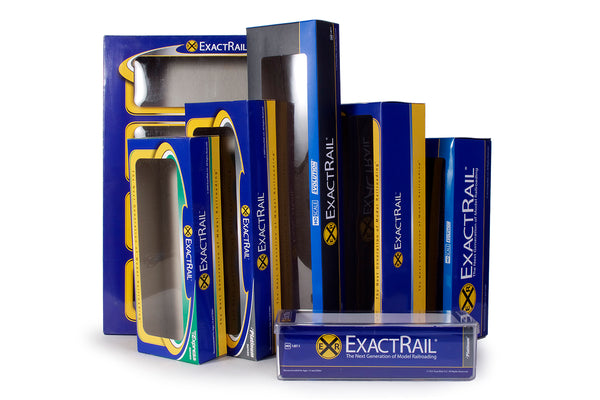
In part 2 I will talk about N scale boxes, as well as packaging for wheels and trucks.
Happy Railroading,

Chris Brimley
11 Responses
Harvey George
Like many, I store my cars in their boxes and take them to a club or shows. They have to store well and endure being moved around. So how the car is secured in the box is most important. The best is where the car nests in a form-fitting cradle and where the transparent top slips over and encloses the cradle. The box itself then holds the top.on the cradle and prevents the car from shifting during handling. NEVER use a top that snaps into place on the cradle. Unsnapping such a package always comes with a jerk that can damage the car.
Ron Bouwhuis
Interesting post on a subject that is in some ways invisible to most consumers, yet in studies has often shown to be highly influential in how a brand is perceived. In this particular case it is perhaps best appreciated by modellers who also happen to be graphic designers. From that perspective I’d venture that ER’s current outer packaging certainly sets the bar among your peers as far as communicating a high-end product.
Of course, the outer box is only part of the packaging, so further to some of the previous comments I’d be curious to read about some of the considerations that went into choosing the inner solution for containing the models. Today’s rolling stock is becoming ever more delicate and fragile. How do you balance the need to display the car, protect it, and ship it economically? There seem to four or five different approaches used by model manufacturers — each with its pros and cons.
Pat Worman
All very interesting about the box designs but what colours and designs are used are of no interest to me.
Its what is packed in the box and how it is packed is important as this box has to be posted in a parcel to me for overseas shipment to me in S. Africa – usually airmail. I can tell you that some models from various manufacturers have suffered minor to moderate damage due to rough handling of the parcel by the postal authorities in either USA or SA (or both). The nest that the model rests in is important to ensure that the model is securely in place to prevent movement or being jarred when the parcel is thrown about or even dropped onto a hard surface.
I’m sorry to note that you have used cardboard boxes when most companies tend to use plastic boxes these days. I have a small layout and cannot put all my rolling stock on the layout at once and they are stored in plastic containers underneath the layout. The cardboard boxes are not very durable and it is not long before the end flap breaks off due to continual opening and closing while the plastic boxes will last indefinitely.
Regards
PAT
Evin P Schaley
The inside “sandwich” style plastic that holds the cars is genius. I have 100+ cars and never had a damaged one and any parts that fell off were easily contained and found.
gary wise
i like the boxes never thought about the time it takes to develop them you all make a very good product
Ron Milne
Thanks for taking the time to show us this brief history of the Exact Rail packaging. When I was a youngster my dad was in the process of building up our family tin plate Lionel layout and at Christmas and birthday times my brother and I looked hopefully for the 1940-1950 Lionel boxes. My dad would be impressed with the Exact Rail product.
Thomas Austin
Very interesting…I would say the marketing of the boxes is very important to show off the product inside…I think you guys made the right decision going to the charcoal box…
If you ever decided to go back to hobby shops…the ExactRail boxes would stand out from the competitors…due to the color change…
And, I have always liked the round, yellow Cross buck sign with the E/R as initials.
TOM SHAY
Hi,
I like the idea of sharing history of the company, it adds a sense of depth to the business on a personal level in my opinion.
I have some of the first issue gray and yellow platinum series cars and was curious what the difference was with the others, now I know!
A quick question, are boxes and storage trays available to purchase separately?
Tom S.
Kevin Fitzgerald
To be honest I never look at the boxes or which product run’s they come from, if I like it and it fit’s I run it. I have plastic injection moulded box liners that are breaking down after about eight to ten years of storage. That is an ITEM that needs looking at not the box colour.
Bert
Nice
Leave a comment
Comments will be approved before showing up.

ALEXANDRE DE FREITAS
January 18, 2016
I really enjoyed , a product like Exactrail mecere a noble presentation as well as safe , the improvement that was made reflects the importance given to the customer , thank you and congratulations .